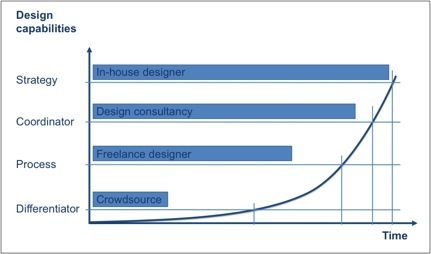Co-written by Zahir A. Dossa
What impact does great design have on a startups' success, and how can they best apply design when on a shoestring budget? It is a mistake to think that plowing design resources into a visual identity, as usual, will do the job. It is important to understand that the startup game is fundamentally different from that of established firms. They are designing a firm and its first product simultaneously and doing this in a high-risk market-technology area with expensive and limited resources.
The infant startup organization has to dynamically balance the building of capabilities, design being only one of these capabilities, while scanning and testing the world for a niche with a good fit. In contrast to established firms, a startup has to develop a niche that offers extreme growth potentials (20 x return), to avoid being stillborn (one x return) or a living dead (four x return).
At first, it is all about the "team" not "the plan." Right off the bat, these newbies are nurturing a culture with a philosophy all their own in order to glue the organization together. If it is going to be a design driven organization, design has to be on board from the outset. Design needs to facilitate the process of crystallizing the culture's values, beliefs, vision and mission. From there, design can be a part of developing the business strategy, as well as, the business model and business plan and translating these three components into actionable design briefs.
The later design comes onboard, the longer it will take the startup to build the crucial understanding of design that will enable design to contribute at a process, connector and eventually at a strategic level.
Startups, like established firms, have four primary options for meeting their design needs: Crowdsourcing individual design tasks, hiring a freelancer, partnering with a design agency or employing a full-time designer.
Crowdsourcing designs are the most affordable short-term route, however, this is not the most cost effective option, since it fails to build any internal sustainable design competencies or even the most rudimentary understanding of design. Most useful design outputs in crowdsourcing are limited to logo or business card designs rather than to a visual identity that is consistent across a startup.
Employing a freelance designer can help startups create designs and build design knowledge as well as process experience. The challenge is finding the right freelancer and retaining that individual when a better offer is received. Only one in a million freelancers are a Fernando Pardo or Jonathan Ivie. If the startup cannot provide enough business to the freelancer, they are forced to look elsewhere, effectively representing a threatening risk to the firm's design continuity.
Partnering with a design agency promises the greatest expertise since they are extremely affordable and do not have to be continuously engaged with the startup. In addition to what a good freelance designer can offer, a partnership with a good consultancy can aid in building coordination capabilities.
In-house designers definitely offer the greatest continuity in terms of building design capabilities, especially strategic capabilities. However, having one or a few employed can result in developing a limited set of skills, as compared to a consultancy. Employing designers is also initially very costly, especially if they are not being fully utilized.
A path for building sustainable design competencies could look something like this. The startup could hold a competition between multiple freelancers and then engage the best designers to create a branding strategy, expressing the startup's promise to the potential users though the initial touch points with the world. Then, employ those designers to manage an extended team of crowdsourcing, freelancers and design consultancies as needed.
Extreme pressure on cash flow, lean learning, speed to market, quick wins and scalability are what sets the startup design needs apart from incumbent firms. However, the rules of the game are "better before cheaper" and "revenue before cost." So, -- penny wise and dollar foolish, when it comes to design, will only help to create a quicker exit strategy for the startup.
Special thanks to Zahir A. Dossa for researching and co-writing this article
